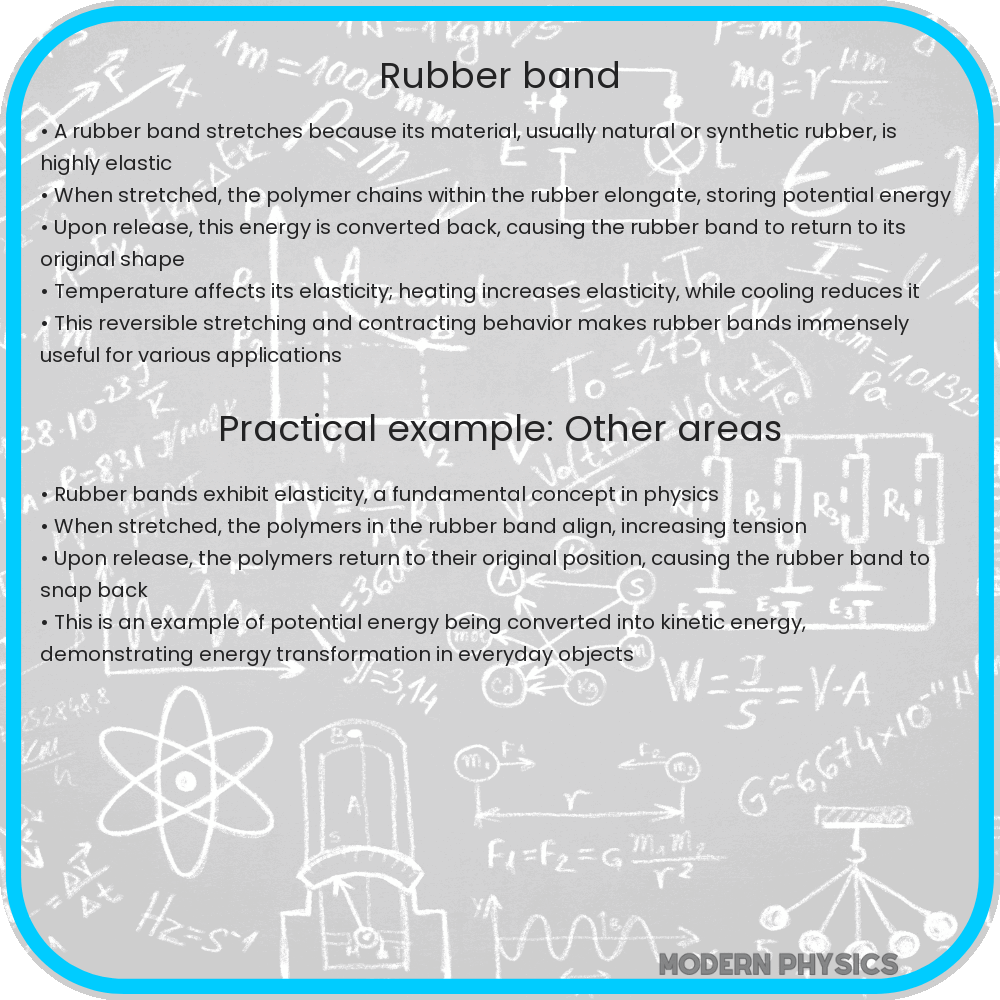Explore the science of rubber bands, delving into elasticity, tension, and force balance, with insights into environmental impacts and applications.

Rubber Bands: Understanding Elasticity, Tension, and Force Balance
Rubber bands, a common household item, serve as a simple yet fascinating example of physics in action. Composed primarily of rubber polymers, these bands demonstrate key principles of elasticity, tension, and force balance. This article delves into the science behind how rubber bands stretch and retract, offering insights into their practical applications and underlying chemical structure.
Chemical Composition and Elasticity
The primary component of rubber bands is natural rubber, a polymer of isoprene, chemically represented as C5H8n. This polymer is notable for its long, coiled chains, which contribute to the material’s unique elastic properties. When a rubber band is stretched, these polymer chains uncoil, and the band lengthens. Upon release, the chains recoil back to their original state, causing the rubber band to retract.
Tension and Hooke’s Law
When a rubber band is stretched, it experiences tension—a force that attempts to return the band to its original length. This behavior is governed by Hooke’s Law, which states that the force exerted by an elastic object is directly proportional to the extent of its deformation, provided the deformation is within the elastic limit. Mathematically, Hooke’s Law is expressed as F = kx, where F is the force, k is the spring constant, and x is the displacement or stretching from the original position.
Force Balance and Equilibrium
Force balance is crucial in understanding how rubber bands function. When stretched, two primary forces are at play: the internal restoring force due to the band’s elasticity and the external force applied to stretch it. At equilibrium, these forces balance each other. This state of balance is not only crucial in rubber bands but also underpins many mechanical systems and structures.
Next, we will explore the practical applications of these principles, including how variations in temperature and chemical composition affect the elasticity and tension of rubber bands. Additionally, we will delve into the environmental impacts of rubber production and disposal, highlighting the importance of sustainable practices in the rubber industry.
Applications and Environmental Considerations
Rubber bands find applications in various fields due to their elasticity and tensile strength. In everyday use, they are employed for bundling objects, while in orthodontics, they assist in aligning teeth by applying consistent force. In engineering, the principles governing rubber bands are extrapolated to design suspension systems, vibration dampers, and even in aerospace technology for shock absorption.
Impact of Temperature and Composition
Temperature significantly affects the elasticity of rubber bands. At higher temperatures, the polymer chains become more agitated, leading to increased elasticity. Conversely, in colder conditions, the bands become stiffer and less elastic. Additionally, the presence of additives like sulfur in vulcanization alters the properties of rubber. Vulcanization introduces cross-links between polymer chains, enhancing strength and elasticity.
Sustainability and Environmental Impact
The production and disposal of rubber, including rubber bands, raise environmental concerns. Natural rubber is harvested from rubber trees, which, if not sustainably managed, can lead to deforestation and biodiversity loss. Furthermore, the disposal of rubber products contributes to landfill waste. Recycling and responsible disposal of rubber products are essential for reducing environmental impact.
Conclusion
Rubber bands, while simple in appearance, exemplify intricate physics principles like elasticity, tension, and force balance. Their functionality is deeply rooted in their chemical composition, primarily natural rubber, and is influenced by factors like temperature and vulcanization. Beyond their practical uses, understanding the behavior of rubber bands sheds light on broader concepts in physics and engineering. However, it’s imperative to consider the environmental implications of rubber production and waste. By integrating sustainability into the life cycle of rubber products, we can harness their benefits while minimizing ecological impact.
